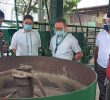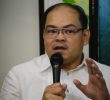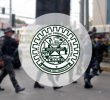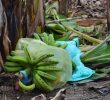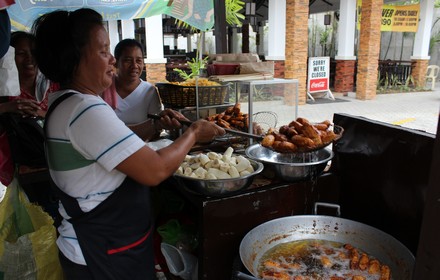
NOT ENOUGH. Vendor Annabel Lincuna says her income in selling banana cue is not enough to sustain her family's needs. (davaotoday.com photo by Medel Hernani)
Ordinary folks say deteriorating incomes and high prices of basic commodities overshadow the bright prospects for the New Year.
By MARILOU AGUIRRE-TUBURAN
Davao Today
DAVAO CITY, Philippines — Businessmen and government authorities are bullish that the city’s positive figures in investments and tourism last year will linger this year — a boost hardly felt by Davao folks.
“2011 was a progressive year for Davao City. With high hopes and spirits, we’ll have more developments and progress this 2012,” lawyer Erwin Alparaque, assistant city administrator told Davao Today. Last year, Davaoeños have seen the rise of new establishments like Ayala’s Abreeza Mall and the unfinished SM mega-mall.
Alparaque said more hotels, convention centers and condominiums will also be constructed, while more investors are eyeing the food processing business. “There will be more infrastructure projects and more activities to bolster both the economy and tourism aspects of the city,” he added.
Lawyer Tristan Dwight Domingo, head of the city’s Business Bureau, said a number of Information Technology and BPOs (business process outsourcing) are already securing their permits. Data from his office noted the number of establishments in the city rose by 32.87 percent from 24,611 to 32,700 in 2010. Investments also increased by 69.43 percent in 2010 from 2006 data. More than 60 percent of investments in the city were in real estate and property development in the last 10 years.
Ordinary folks, however, say deteriorating incomes and high prices of basic commodities overshadow the bright prospects for the New Year.
For ambulant vendor Annabel Lincuna, 40, “I don’t know how we survived. I and my husband are helping each other to sustain our needs.” She sells banana cue (skewered fried bananas) from Monday to Saturday along the city’s main streets. Her customers come from all walks of life, mostly employees from nearby offices and students from nearby schools. And like instant food chains that have drive-throughs, jeepney drivers would also stop along the road, to buy the ‘fastfood’ banana cue from her.
With four children, three who are now in college, she says of her income, “kulang gyud sa among panginahanglan (it’s really not enough for our needs),” she sighs.
Aside from Lincuna, worker Ramil Sencio, 38, says, “ang akong sweldo sa tibuok gyud na galastuan dili gyud makaya. Bisag 7,000 kulang gyud kaayo.” (My salary is really not enough for our expenses. Even if I receive (PhP) 7,000 (every month), it’s really not enough.)
Sencio, married with two children, works in a vinegar factory for 20 years already. Whenever he has no work, he plies his motorcycle and does electrical services to earn extra income. “Kung saligan lang nako ang sweldo, dili gyud paigo” (It’s not enough if I’ll only depend on my salary) he said.
More tourists, more business?
The local government also expects more tourist arrivals this year as it looks forward to the celebration of Araw ng Davao on March, in time for the city’s 75th founding anniversary. The number of tourist arrivals increased by 18.92 percent in 2010 with 682,821 from 574,165 in 2006.
The upbeat tourist potentials in Davao was explained by assistant administrator Alparaque. “Because Davao has a lot to offer,” he said. The city has one of the lowest crime rates in the world with an average of 0.8 in every 10,000 persons per month. The Davao City Police Office has consistently been chosen as the Best Police in the whole archipelago. The Davao City Peace and Order Council has been promoted to the Philippine Hall of Fame for consistently being the best in the country. The complete infrastructure of the city, such as the airport and the seaport, makes doing business here low-cost.
Former DCCCI (Davao City Chamber of Commerce and Industry) president and chairman of the board lawyer Bienvenido Cariaga said Region XI has a good prospect in the real estate development. “The most solid investment in the world is real estate. It doesn’t rot as time goes by. It is where the best investment is. That’s the only thriving business investment in the region,” Cariaga said. He said based in their studies in the DCCCI, restaurants with specialties are businesses that really make money such as Ahfat and Penong’s.
The cost of doing in the city is very competitive compared to the rest of Asia. Based in the evaluation of Foreign Direct Investment Magazine in 2007 and 2009, Davao emerged as one of the top five most cost-effective cities in Asia and the most cost-effective city in the Philippines. It listed the city as the 10th “Asian City of the Future.” In 2011, the City Mayors Foundation ranked Davao as the 87th fastest growing city in the world. In 2008, the Department of Tourism named it as the most livable city in the Philippines.
But beyond the accolades, the real reason why business is perking up in the city is because of the low wages, coupled with low taxes, fees and charges — one of the lowest in Philippine cities. Workers in tourism, real estate and construction get a cheap PhP 286 or US$ 6.5 basic daily wage and PhP 15 cost of living allowance. Business investors are tax free for the first five years, while business permit costs cheaply. Information from the Davao City Investment Promotion Center said they provide fiscal incentives to registered enterprises such as: exemption from building permits fees and other fees and charges; exemption from Mayors permit fees, business sales taxes, other fees and charges within three years from the start of commercial operations; and exemption from the basic real property tax due the City, excluding the barangay share and the Special Education Fund, under the Tax Code for a period of two years from the effectivity (accrual) of the real property tax.
No trickle-down effect
Chibo Tan, spokesperson of Kilusang Mayo Uno-Southern Mindanao said, “so-called investments in the city have not trickled down to the urban poor and the workers.”
“Ordinary people can hardly buy from the expensive commodities from these newly-put up malls. The people are suffering in economic crisis,” Tan said, citing that in Davao region, a family of six has to make do with PhP 286 daily wage although it needs at least PhP 720 daily to live decently.
Inflation rate has upped from 3.8 percent in 2010 to 4.8 percent in 2011, making the purchasing power of peso weaker and lessening the buying capacity of workers who are also consumers themselves. The price of PhP 1oo in 2010 became PhP 110 in 2011.
“Kamahal sa presyo karon kesa sa una!,” (the price is higher now compared before!) vendor Lincuna said. Most of her income is spent on rice, viands and school needs of her children.
Drivers are already up in arms with the two oil price increases at the start of the year. The oil price hikes are bound to trigger a domino effect on the prices of other basic commodities.
For Bagong Alyansang Makabayan (BAYAN)-Southern Mindanao, the year 2012 spells more economic suffering
“It would even be harder with continuous price hikes especially oil and services like Philhealth premium in the absence of government effort for substantial wage hike,” Franchie Buhayan, BAYAN Secretary General, said. (Marilou Aguirre-Tuburan/davaotoday.com

